Dear Artist,
Along the Alabama River just south of Selma, there’s a horseshoe-shaped turn resembling an inland island, where a cotton plantation once stood. In 1816, 18 slaves were brought to this bend by a man named Gee from North Carolina. A generation later, his cousin, Pettway, took over the plantation and brought more slaves — one of them, Dinah Miller, brought to the United States on a slave ship in 1859, has descendants living there today. When the last remaining African American slaves were emancipated on June 19th, 1865, many from the Pettway plantation, who now also went by the name of Pettway, continued to work there as sharecroppers.
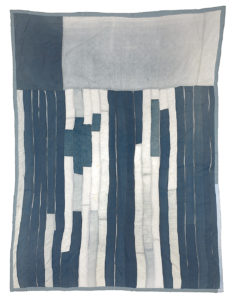
Blocks and Strips Work-Clothes Quilt, c. 1950s
Denim and cotton twill
87 x 66 inches
by Emma Lee Pettway Campbell (1928-2002)
As one of the poorest and most isolated communities in the country, accessed only by a muddy road and a sporadic ferry, Gee’s Bend had, by the Great Depression, already received emergency aid and then attracted the attention of the Resettlement Administration (later renamed the Farm Security Administration) as part of the New Deal of 1935. The agency took over the plantation, divided the land and rented it to the tenants. The agency provided a nurse and plans began to establish a school, a store, a blacksmith shop and cooperative cotton gin. Within a decade, many of the tenants were able to buy their farms, though the isolated hamlet continued without electricity, running water or telephones. And when the Civil Rights era families of Gee’s Bend organized to register to vote in 1962, the local authorities cut off the ferry service to the nearest registration office.
In 1966, an Alabama quilting co-operative was formed as a way to connect isolated communities and to try to generate some income. Quilts made of discarded strips of fabric, feed sacks, recycled work clothes and old dresses had been made by the women of Gee’s Bend for generations as a way to keep their families warm in unheated houses. The Freedom Quilting Bee enabled the quilters to collaborate to now sell their quilts to outsiders. In 2002, Atlanta-based collector and historian Bill Arnett, as part of a project to survey the visual tradition of the African American South, took an interest in the quilts created by the women of Gee’s Bend, and organized an exhibition at the Museum of Fine Arts, Houston. The free-form and individual-yet-congruent, contemporary, emblematic, energetic, minimalist and exquisitely graphic quilts emerged in this new context as one of American art’s most important contributions.
The Exhibition The Quilts of Gee’s Bend travelled to 13 museums including the Whitney, the High Museum of Art, Atlanta, MFA Boston, the Milwaukee Museum of Art, the Cleveland Museum of Art, the Corcoran Gallery in Washington, D.C. and the de Young Museum, San Francisco. In 2014, Bill Arnett, through his nonprofit Souls Grown Deep, donated 57 works from his collection of contemporary African American artists from the Southern United States to The Metropolitan Museum of Art. The ferry service to Gee’s Bend was finally re-instated, after 44 years, in 2006.
Sincerely,
Sara
PS: “My mother learnt me how to quilt.” (China Pettway, b. 1952)
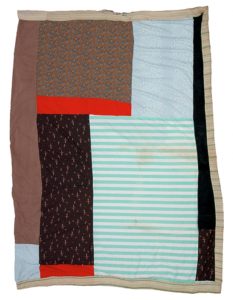
Blocks and Stripes, c. 1980
Cotton, crepe, acetate, polyester, corduroy
89 x 65 inches
by Irene WIlliams (1920-2015)
Esoterica: When organized into types of designs, most of the Gee’s Bend quilts fall into a category loosely called, “my way.” The designs are improvisational — they don’t follow the classic foundations found in most American quiltmaking traditions. “Bend quiltmakers have been guided by a faith in personal vision; most of them start with basic forms and head off “their way” with unexpected patterns, unusual colors, and surprising rhythms,” reads the description by Souls Grown Deep. “Theirs are handsome, if unorthodox, works of art, yet the shared unorthodoxy attests to the stabilizing power of a tradition that, for many decades, has fostered individualism and even eccentricity. By making what they want to make, these women reveal innovative ways of looking at fabric, design, and format and have produced work that is utterly original and ranks with the finest abstract art in any tradition.”
Have you considered a Premium Artist Listing? With each letter, an artist is featured at the bottom of this page. The Premium Artist Listings are a means of connecting artist subscribers through their work. Proceeds from each listing contribute to the production of The Painter’s Keys.
“I learned quilting by myself, messing up quilts, doing the best I could, you know, by being a young girl and didn’t know how, just piecing whatever I could get, sewing it together trying to make quilts. That’s the only way I learned, and after that, when I got married, after while, I learned pretty good. I got good ideas from my mother-in-law, Henrietta. Me and her sewed together. When I had children I had to do better. Made quilts out of old dress tails, shirt tails, that’s the way I did so the children would be covered up.” (Allie Pettway, 1916-2010)
Featured Workshop
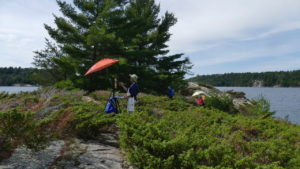 The Killarney are of Ontario is in what is called the ‘near north’. The landscape is wild and rugged. Giant granite cliffs plunging deep into the glacial lakes. There are no roads leading to our painting locations. We travel by a large, sturdy pontoon boat. This is a self-catered retreat. You bring your own provisions and cook your own meals in our fully equip cabins at a northern camp. Our instructor, Keith Thirgood, has been teaching artists his own unique approach to painting for over 12 years. Learn how to find order in the chaos, control your colours and create paintings that work. Learn modern colour theory, values, shapes and lines, what makes for a good painting. This retreat is suitable for beginners wanting to learn to paint in a fun, outdoor location, as well as more experienced studio artists who want to try plein air, plus artists who are looking to loosen up and paint in a more post-impressionist style. To find out more and register, please visit www.wilsonstreetstudios.
The Killarney are of Ontario is in what is called the ‘near north’. The landscape is wild and rugged. Giant granite cliffs plunging deep into the glacial lakes. There are no roads leading to our painting locations. We travel by a large, sturdy pontoon boat. This is a self-catered retreat. You bring your own provisions and cook your own meals in our fully equip cabins at a northern camp. Our instructor, Keith Thirgood, has been teaching artists his own unique approach to painting for over 12 years. Learn how to find order in the chaos, control your colours and create paintings that work. Learn modern colour theory, values, shapes and lines, what makes for a good painting. This retreat is suitable for beginners wanting to learn to paint in a fun, outdoor location, as well as more experienced studio artists who want to try plein air, plus artists who are looking to loosen up and paint in a more post-impressionist style. To find out more and register, please visit www.wilsonstreetstudios.
Featured Artist
Mary’s interest in pastel painting began during her years at Whitworth College in Spokane, WA where she majored in art and elementary education. Though she has worked in watercolor and oil as well as calligraphy, her interest has consistently turned primarily to pastel because of the medium’s potential for glowing, vibrant color and the harmony achieved in bringing together lights and shadows.

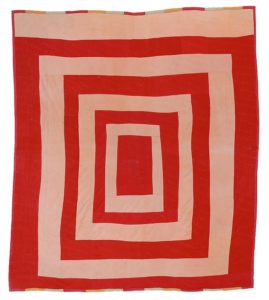
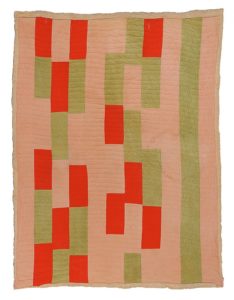
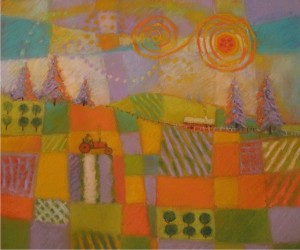



30 Comments
Beautiful…thank you for this. As always, these posts are inspiring.
These might possibly be some of the most beautiful, powerful and intriguing quilts I have ever seen! Their clarity of wabi-sabi expression pleases that deep place within me. Thank you for the story about the lives that belongs to them.
Awesome posting, Sara, as always. And, in no way to compare stories to the trials and tribulations and triumphs of the quilt-makers of Gee’s Bend, but my late mom (born in rural Ontario in 1920) made quilts with found and worn out materials in the same kind of “my way” designs from the 1940s through to the 1990s. I am the proud owner of a half dozen of them (my large family grouping owns the rest). And they are , not only amazing works of art, but fabulously warm on cold Canadian winter nights!
Thank you for the history, painful as it is. What shines through is the creative spirit, as art heals. Wonderful folk art; sophisticated and authentic. Heartbreaking history and is a “must” to revisit if we are ever to make this right. Thanks again!
Stunningly beautiful. Souls that grew deep. We so need this in our lives today.
A beautiful though poignant tale of the slaves and their lives after.. in a small bit of America.. and the women showed their courage, talent, creativity and imagination in their beautiful quilts. Abstract art at a whole new level
I saw this exhibit when it first came to Washington DC. It is just amazing, out of the hardships these women endured, wonder art emerged. It made me cry right there in the midst of the quilts. They have also been featured in CBS Sunday Morning show .
The Artist within, cannot be silenced, broken nor subdued, as where slavery has endured for so many years has tried, and still does exist in the form of racism today. However, an artist outlet, in my opinion, is their emotional outlet to endure and create art! An incredibly true story of how the artists endured is of particular interest with African Art, thank you for the story, I’ve shared this story with friends and family. A wonderful topic for this day, June 19, 2020.
Vera~ Racism is evil, of course, but actual slavery, as I am sure you know, still exist today in many parts of the world. It exists in the form of slavery, in the most literal sense of that word. There is slavery by Blacks, Whites, slavery of children, political opponents, religious opponents, the list is long. When I consider the many actual examples of slavery in the year 2020, I do not feel in any way enslaved when I am simply treated or regarded in some racist manner.
Wonderful way to frame our thinking about what Juneteenth means. Thank you!
Inspiring works and lives. Wondering if Pettway is near the Edmund Pettus Bridge near Selma?
Thank you Sara.
Love these! My favorite blanket to sleep under on my Grandma’s couch was made from an old wool coat. Why did I love it? The wool was scratchy but it had a pocket on the back side in what was once the coat lining! I found that fascinating! My grandparents were southern Ohio farmers. Every usable scrap of anything, got used again and again. Almost everything, I am supposing , had a previous history.
Sorry, in my previous comment I meant to acknowledge that the story of the quilts in your article, Sara, comes from the long shameful story of slavery, poverty and bigotry….that never seems to go away! We have to work harder for a better today!
I had the good fortune to see these quilts in New Mexico some years ago. Their beauty stayed with me. I just have to hear Gee’s Bend and I think of these amazing, colourful and creatively designed works of Art. Thank you for the reminder of these stalwart ladies.
I went to see this beautiful show (and accompanying print exhibition) TWICE at the deYoung in San Francisco, but I did not know this whole backstory. Thank you so much.
In an interview, Amy Sherald the artist who painted the portrait of Michelle Obama referred to the Gees Bend quilts as a major influence in creating the geometric pattern in Michelle Obama’s dress. Several years ago I was able to see an exhibit of Gees Bend Quilts. Very inspiring.
Saw them at the Whitney in NYC.
Awesome! d
Arrow to the heart!
Visited the Gee’s Bend community several years ago and talked with several of the artists and admired the quilts
in the small retail community room there. The artists were quite welcoming and eager to discuss their work. It is well worth the miles of out of the way roads (all paved) to visit if you are in the area
Sara, your post today about the Gees Bend Quilters is so perfect for Juneteenth.
I worked for many years in a day job as a graphic designer for quilting magazines, and when the exhibits of the Gees Bend quilters came on the scene I fell in love. Their wonderful abstract designs caught the attention of younger “modern quilters” and influenced so many of them, and also won well deserved attention of the general art world.
The talents of the Gees Bend quilters are marvelous and should take a prominent place in America’s history.
Thank you Sara!
Myself and my Hoosier sister saw the Gee’s Bend exhibition and were absolutely overwhelmed of the beauty and soul
illustrated through the threads of the cloths. An exhibition that should travel around the country again!!
Again you hit another one out of the park. Must move you up to a first read and a superb educational source for the autodidact. The Gee’s Bend and Quilts as a story was wonderfully told. All ingredients were there, nice beginning, aroused my interest, give me some education, add to what I did not know (plenty) and the day being Juneteenth Day was perfectly timed. Take a bow. Looking forward to the next article- letter
As a long-time Houstonian, I had the good fortune to visit the 2001 exhibit of Gees Bend quilts numerous times. MFAH hosted a second exhibit in 2006 as heavily attended as the first. The museum has also included examples of these magnificent works in several craft exhibits as well, the most recent just last year. One could speak of the triumph of art over prejudice and repression as the work of these largely uneducated women has gained international acclaim, but there also are levels of irony that unfold as our history continues to be written in the daily news. Several related articles:
https://www.smithsonianmag.com/arts-culture/fabric-of-their-lives-132757004/
https://www.mfah.org/blogs/inside-mfah/a-legacy-from-gees-bend-lutisha-pettways-bars-quilt
Dear Sara
Thank you for directing me to Souls Grow Deep. It has done something for me that I do not have words for. Anne
Ken Burns talked about quilts in an interview on Alec Baldwin’s ‘Here’s the Thing’, forgive me I will have to paraphrase, but the gist was that quilters have been creating sophisticated abstract art for hundreds of years, long before it became a’thing’ in the modern art canon. I think he collects them…
Great article as always, thank you for the wisdom.
Self expression is a way to have self sovereignty.
Self expression is a way to have self sovereignty, especially for Black women.
Gee’s Bend displayed their quilts at the Museum of Art in Columbia SC a few years back and I was lucky enough to have seen it. As an artist and a quilter, it was exciting to see how they turned the ordinary into something useful.
You may not know that these quilts (as well as outsider art) fill Bill Arnett’s two volume oversized books Souls Grown Deep. One day the author was shown a photo of someone’s mother but what excited him was the quilt thrown over a pile of firewood in the background. It was a Gee’s Bend quilt and that began a voyage of discovery by bus throughout the south. It produced the books + exhibitions. His son is married to Jane Fonda’s African American daughter. Fonda contributed hugely to this incredible accomplishment. I’m so relieved the quilts and art were documented while many of the artists were still alive. My apologies if this has already been mentioned :)